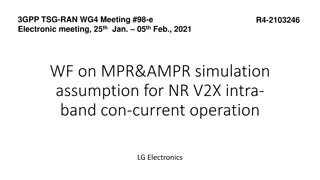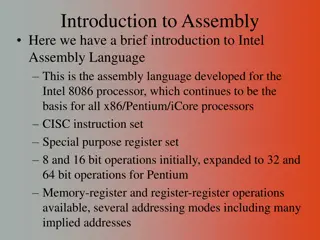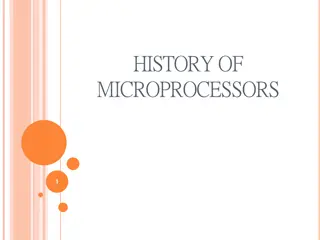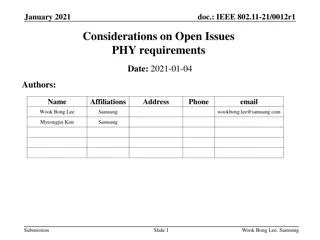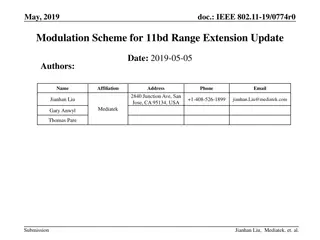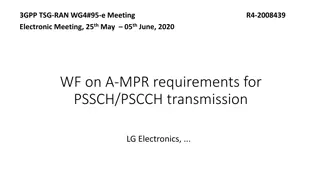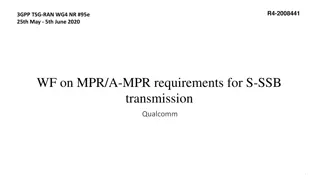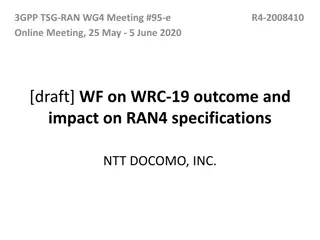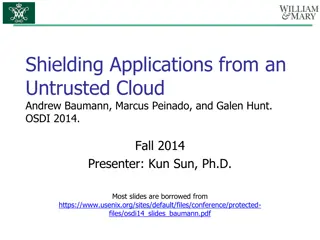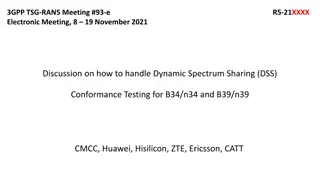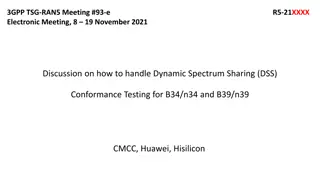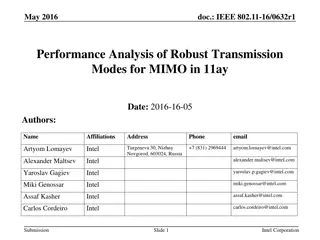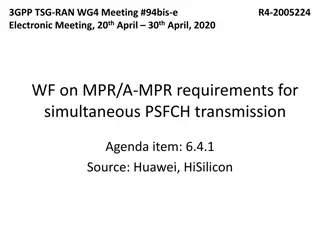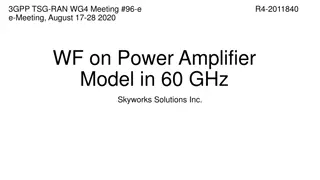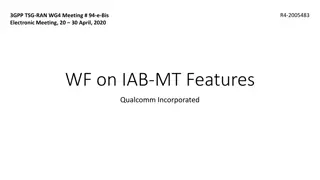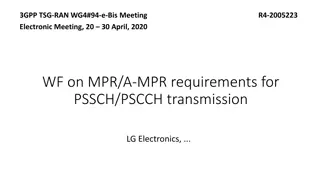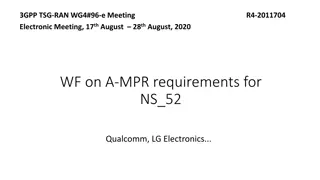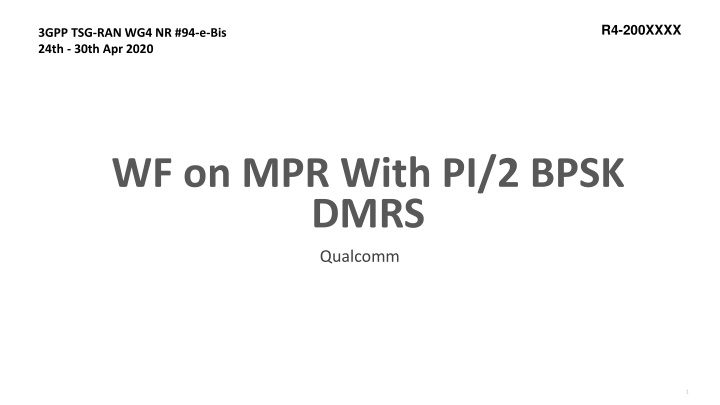
RAN4-200XXXX 3GPP NR MPR Proposal Analysis Qualcomm vs. Huawei
Explore the proposals by Huawei and Qualcomm regarding MPR requirements for Pi/2 BPSK in 3GPP NR, evaluating the potential improvements and impacts on RF requirements. Discover the considerations for enhancing Pi/2 BPSK DMRS and the discussions on revisiting power boosting levels for MPR in the context of Rel-15 and Rel-16 standards.
Download Presentation

Please find below an Image/Link to download the presentation.
The content on the website is provided AS IS for your information and personal use only. It may not be sold, licensed, or shared on other websites without obtaining consent from the author. If you encounter any issues during the download, it is possible that the publisher has removed the file from their server.
You are allowed to download the files provided on this website for personal or commercial use, subject to the condition that they are used lawfully. All files are the property of their respective owners.
The content on the website is provided AS IS for your information and personal use only. It may not be sold, licensed, or shared on other websites without obtaining consent from the author.
E N D
Presentation Transcript
R4-200XXXX 3GPP TSG-RAN WG4 NR #94-e-Bis 24th - 30th Apr 2020 WF on MPR With PI/2 BPSK DMRS Qualcomm 1
Open Issues 1. Issue 1-1-1: Rel-15 MPR requirement for Pi/2 BPSK Proposal 1 (Huawei): Revisit firstly before consider whether MPR improvement based on Pi/2 BPSK DMRS should be defined in Rel-16 Proposal 2 (Qualcomm): FFS further optimization of MPR for ZC based DMRS; this evaluation can proceed in parallel under the TEI WI. 2. Issue 1-1-2: Rel-16 MPR requirement for Pi/2 BPSK Proposal 1 (Huawei): If Rel-15 MPR for Pi/2 BPSK cannot be revised, then there is no RF requirements should be specified for new DMRS design, based on following observations: MPR can be improved a little bit for Pi/2 BPSK DMRS with FDSS compared to ZC DMRS with FDSS, but not too much The MPR improvement even with newly designed DMRS sequence cannot reach the power boosting level defined in Rel-15 spec Proposal 2 (Qualcomm): Pi/2 BPSK DMRS can be treated as a separate specification in the MPR tables (but MPR number can be discussed). 2
Background (1) Rel-15: MPR values for Pi/2 BPSK waveforms having Zadoff-Chu (ZC) modulated DMRS was agreed for both FR1 and FR2 and placed in the 38.101 specification. The full benefit of BPSK could not be realized due to the DMRS of these waveforms being a higher PAPR ZC modulation. Revised Rel-16 WID on NR eMIMO (RP-192271) states: Perform study and make conclusion in the first RAN1 meeting after start of the WI, and if needed, specify CSI- RS and DMRS (both downlink and uplink) enhancement for PAPR reduction for one or multiple layers (no change on RE mapping specified in Rel-15) Specify core requirements associated with the items specified by RAN1 [RAN4] Identify impact on RF requirements for the reduced PAPR pi/2-BPSK DMRS and, if needed, specify RF requirements Based on RP-192271 a new Pi/2 BPSK DMRS was created for use with Pi/2 BPSK modulated data that has lower PAPR 3
Background (2) - Positions of each company Company Issue 1-1-1: Rel-15 MPR requirement for Pi/2 BPSK Issue 1-1-2: Rel-16 MPR requirement for Pi/2 BPSK Proposal 2. Need RAN4 approves it as a Rel-15 TEI Proposal 2 Intel Rel-15 MPR requirement is connected with the newly designed DMRS sequence. If the requirement is over defined, we need to consider the possible improvement based on a correct basis Rel-15 MPR requirement is connected with the newly designed DMRS sequence. If the requirement is over defined, we need to consider the possible improvement based on a correct basis Huawei We would like to stick to WID wording without increasing WI scope: Identify impact on RF requirements for the reduced PAPR pi/2-BPSK DMRS for FR1 and, if needed, specify RF requirements . Changing MPR for pi/2 BPSK carried over from rel-15 can take place once there is a WI driving it We think that Pi/2 BPSK DMRS with FDSS should be specified in the mpr tables under a separate specification as it is a new DMRS scheme and it does provide palpable benefits. Why must Pi/2 BPSK DMRS achieve Rel-15 power boost levels for mpr improvement to be viable? There are other intermediate targets with tangible benefits. Qualcomm Based on WID, Identify impact on RF requirements for the reduced PAPR pi/2-BPSK DMRS for FR1 and, if needed, specify RF requirements , by this meeting, we need to identify the impact otherwise we need to make the clear conclusion that MPR requirement for Pi/2 BPSK DMRS will not be introduced. Whether Rel-15 power boosting requirement for Pi/2 BPSK needs revisit or not can be discussed in Rel-15 TEI to correct existing requirement if needed, but it is out of scope of Rel-16 eMIMO WI. Samsung Based on our studies presented in R4-2000517 we believe that REL-16 PI/2 PBSK MPR can be improved. This can be done by complementing current MPR table. Improvement and shaping should be further discussed. Enhancement should apply to both FR1 and FR2. Nokia 4
WF on Pi/2 BPSK DMRS The purpose of WI RP-192271 was to Identify impact on RF requirements for the reduced PAPR pi/2-BPSK DMRS and, if needed, specify RF requirements Therefore, the following suggestions on the WF are made: Proposal 1: Add MPR specifications for the new waveform type identified in RP-192271 (pi/2-BPSK DMRS) for FR1 PC2 and PC3 in TS38.101-1 Rel-16. For IE powerBoostPi2BPSK is set to 0,as the same minimum requirements apply for pulse-shaped pi/2 BPSK and non pulse-shaped pi/2 BPSK, no requirements impact identified for introduction of reduced PAPR pi/2-BPSK DMRS companies are encouraged to continue workingstudy on possible possibility of enhancements as majority companies observed MPR improvements. Proposal 2: Study MPR enhancements for Zadoff-Chu based DMRS with pi/2 BPSK data for FR1 as a separate WI under Rel-15 TEI For IE powerBoostPi2BPSK is set to 1, RAN4 study does not support the conclusion that MPR requirements can be further improved compared to that in Rel-15. The objective can be closed without identifying impact on RF requirements. 5

